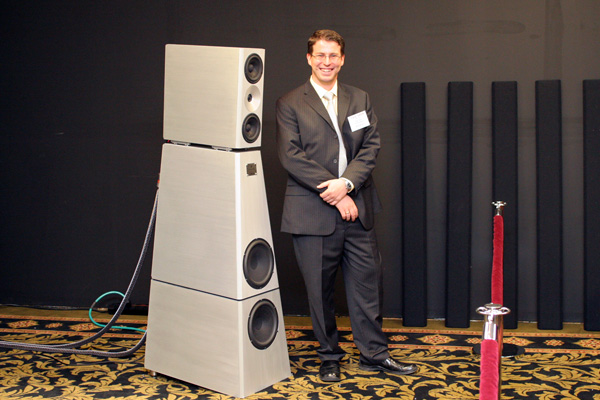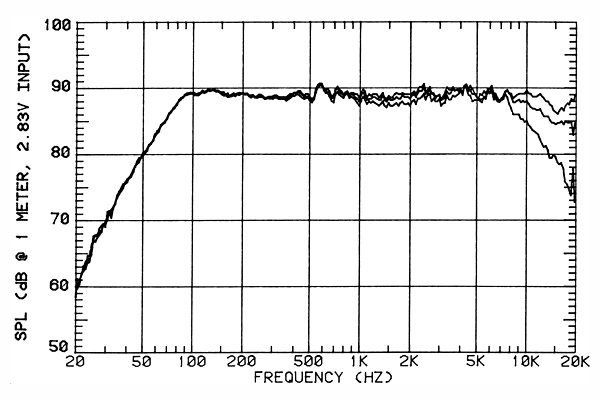 |
||
| March 1, 2007 Searching for the Extreme: YG Acoustics' Yoav Geva on Loudspeaker Design and Measurements His claims are bold -- "indistinguishable from live sound," "zero compromise," "breaks the current barriers of audio reproduction" -- yet Israeli-born Yoav Geva, designer for Colorado-based loudspeaker manufacturer YG Acoustics, stands firmly by them. He seems confident that his products’ technical acuity surpasses competing designs in the marketplace. As part of the research for my upcoming "The World’s Best Audio System" column on his newest product, the Kipod Studio ($38,000 USD per pair), I set out to determine just how the science of loudspeaker design shapes the creation of a YG Acoustics model.Ask ten different speaker designers how much their design work is based on listening, how much on measurements, and how much on theory, and you’ll get ten different answers. Each will have his or her own unique recipe for a successful design. After all, loudspeakers have not converged to all look and sound alike -- in fact, a wide array of designs is available, each with its signature traits, claims, and of course, sound. Therefore, and taking into account Geva’s bold claims of his speakers’ accuracy, I thought the first question I would ask him would be: How much of YG Acoustics’ speaker designs are based on science, how much on listening, and why? His answer was unambiguous: "Our entire design process is science-based, and listening serves as an evaluation rather than a development tool. At each turn during the design, we listen and make sure that the perceived sound quality matches the scientific prediction. In some cases, we encounter conflicts. When this happens, rather than just selecting the better-sounding option, we perform further research until we fully understand the phenomenon in scientific terms. Using this new insight, we then develop solutions that incorporate the technological advantages of each option, and do not stop until we find something which measures and sounds better than both initial candidates. This way, we can guarantee that each and every component in our speakers is there for a well-understood reason. As you may imagine, with a large number of components in each product, our method requires literally hundreds of scientific measurements and hundreds of listening tests before a product reaches the market. I would also like to mention that before a product comes to market, I personally spend at least six months ‘living’ with it at home. Only once I feel that I fully enjoy listening to music on the speaker in the long run is it deemed a viable product." So with such measurement-based rigor as is applied in the YG Acoustics design process, the natural question is whether someone can build a competent loudspeaker without objective measurements? After all, we’ve all heard about audio designers who use only their ears, and no scientifically valid measurement process to speak of. In fact it has been said by some that the ear is the most critical measurement device we have, far more sensitive than any electronic equipment. Again, Geva’s reply left no wiggle room: "Absolutely not, in my opinion. The industry is filled with self-proclaimed ‘gurus with golden ears,’ who can sometimes create musically satisfying prototypes. However, they always fail when it comes to delivering a reliable, consistent product that actually sounds the same as the prototype. Sooner or later one of their suppliers will perform a seemingly negligible change in a minor component, and the entire loudspeaker will sound completely different. Without science, a designer has a very low chance of being lucky over and over again."
So YG Acoustics’ stated goal is to deliver a loudspeaker that sounds like real music. To me, that means an accurate loudspeaker. But what is accurate, exactly? How do you define such a term when there are literally hundreds (if not more) of various design criteria, all types of objective measurements, not to mention individual interpretations of all the data? I asked Geva to define accuracy, and thereby provide his objective in regards to the finished product: "My approach is quite unforgiving. As such, a loudspeaker to me is only accurate if it sounds exactly like live music -- natural timbre, no artificial mellowing, no compression of dynamic peaks (within a certain overall volume and room-size limit, of course), lifelike soundstage, etc. Technologically, a speaker that fulfills all of the measured criteria [discussed here as well as on Geva’s website] is indistinguishable to a human ear (or at least to my ears and those of my colleagues) from live music." One of the claims made for all YG Acoustics speakers is their incredibly flat frequency response. I’ve always wondered just how flat a speaker needs to be to be deemed accurate. I’ve also wondered if there is a threshold for flat response beyond which flatness fails to matter. I asked Geva if all frequency-response aberrations are audible to some degree, and just how flat a speaker needs to be to be called accurate. "If a speaker is accurate to within +/-1dB or less, and offers wide dispersion in all dimensions (horizontal and vertical), so that in-room response is also accurate, then in terms of SPL flatness it is perfect, (i.e., its deviations are less than those inherent to our ears). However, all other aspects of performance must also be well optimized, to avoid other weak spots." One of those other aspects of performance that Geva strives for is phase uniformity -- in addition to flat frequency response, he claims excellent phase characteristics for his speakers. In fact, he has stated that his designs’ phase characteristics are matched only by those of single-driver speakers, without, of course, the inherent limitations of those designs. I asked him to explain the relationship between phase uniformity and flat frequency response, and how he arrives at both ideals simultaneously. "For a single driver, phase response and frequency response at any given listening position are related through a mathematical formula called [the] Hilbert-Bode Transform. Ideally, a single pistonic driver with a flat frequency response has perfect time-domain behavior. The problems start with multiple drivers and/or drivers that are forced to operate outside their pistonic band. Then, optimizing phase becomes much more difficult. The main problem is that off-the-shelf loudspeaker design software, which practically all of our competitors use, cannot optimize both SPL and phase at the same time -- improve one and you might sacrifice the other. We develop our own design software, through which we can optimize both. This is our single most significant proprietary technology."
I admire the approach Yoav Geva takes with his YG Acoustics loudspeakers, and will soon be investigating the Kipod Studios. The question for me is whether YGA speakers’ claimed technical accuracy translates into perfect musical enjoyment. To say that I can’t wait would be an understatement. ...Jeff Fritz To learn more about YG Acoustics' products, visit www.ygacoustics.com.
Ultra Audio is part of the SoundStage! Network. |

